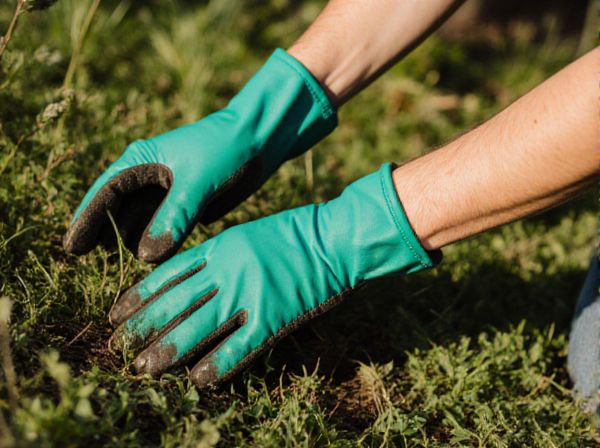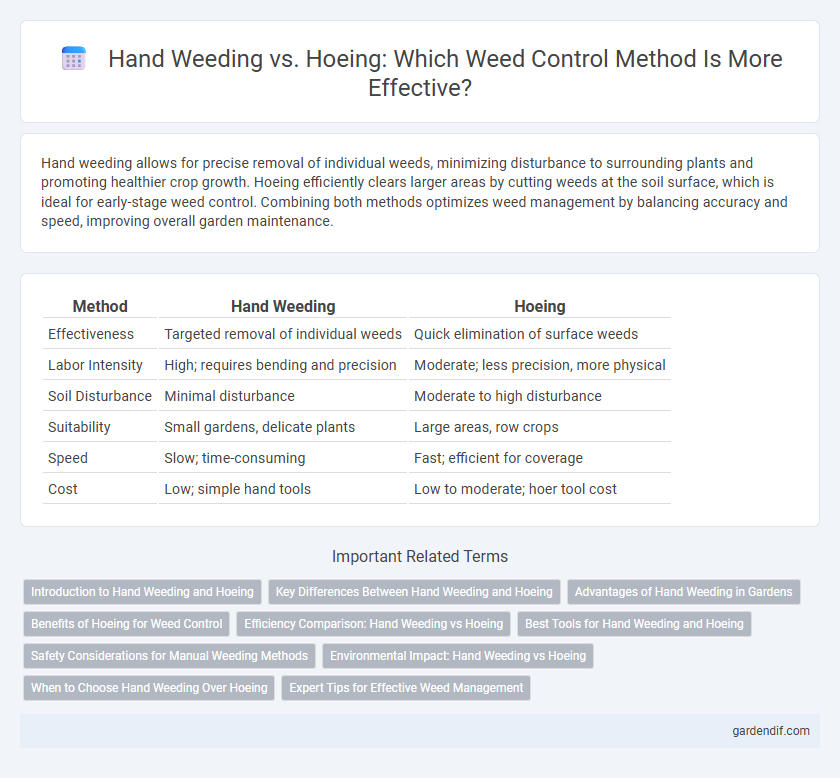
Hand weeding vs hoeing Illustration
Hand weeding allows for precise removal of individual weeds, minimizing disturbance to surrounding plants and promoting healthier crop growth. Hoeing efficiently clears larger areas by cutting weeds at the soil surface, which is ideal for early-stage weed control. Combining both methods optimizes weed management by balancing accuracy and speed, improving overall garden maintenance.
Table of Comparison
| Method | Hand Weeding | Hoeing |
|---|---|---|
| Effectiveness | Targeted removal of individual weeds | Quick elimination of surface weeds |
| Labor Intensity | High; requires bending and precision | Moderate; less precision, more physical |
| Soil Disturbance | Minimal disturbance | Moderate to high disturbance |
| Suitability | Small gardens, delicate plants | Large areas, row crops |
| Speed | Slow; time-consuming | Fast; efficient for coverage |
| Cost | Low; simple hand tools | Low to moderate; hoer tool cost |
Introduction to Hand Weeding and Hoeing
Hand weeding involves manually removing weeds from the soil, allowing for precise control and minimal disturbance to surrounding plants. Hoeing uses a garden tool with a flat blade to cut and uproot weeds, efficiently covering larger areas and disrupting weed growth below the soil surface. Both techniques play crucial roles in integrated weed management strategies to maintain healthy crops and garden beds.
Key Differences Between Hand Weeding and Hoeing
Hand weeding involves manually pulling weeds from the soil, allowing for precise removal of unwanted plants without disturbing nearby crops. Hoeing uses a sharp-edged tool to cut weeds just below the soil surface, providing faster coverage of larger areas but with less precision. Key differences include the level of soil disturbance, time efficiency, and suitability for various garden sizes and crop types.
Advantages of Hand Weeding in Gardens
Hand weeding allows for precise removal of individual weeds without disturbing nearby plants or soil structure, promoting healthier garden growth. It minimizes soil erosion and preserves beneficial microbes essential for plant health. This method is especially effective in small garden beds and around delicate crops where mechanical tools could cause damage.
Benefits of Hoeing for Weed Control
Hoeing offers precise weed control by disrupting weed roots just below the soil surface, preventing regrowth more effectively than hand weeding. It saves significant labor time in large garden beds or crop fields, enhancing efficiency for farmers and gardeners. Regular hoeing also aerates the soil, promoting healthier plant growth while suppressing weed competition.
Efficiency Comparison: Hand Weeding vs Hoeing
Hand weeding offers precise removal of individual weeds, making it highly effective for small gardens and delicate plants but is labor-intensive and time-consuming for larger areas. Hoeing allows quick elimination of surface weeds over extensive spaces, improving efficiency with less physical strain but may miss deeply rooted or closely spaced weeds. Comparing efficiency, hoeing excels in speed and area coverage, while hand weeding provides thoroughness and precision, suggesting a combined approach often yields optimal weed control.
Best Tools for Hand Weeding and Hoeing
The best tools for hand weeding include ergonomic hand forks and stainless steel trowels, which provide precision and minimize soil disruption around delicate plants. For hoeing, a stirrup hoe or a scuffle hoe offers efficient removal of surface weeds by cutting roots just below the soil surface. Both options enhance weed control by targeting different soil depths and weed types, ensuring a cleaner garden bed.
Safety Considerations for Manual Weeding Methods
Hand weeding minimizes soil disturbance and reduces the risk of damaging nearby plants compared to hoeing, making it a preferred method for safety-conscious gardeners. Hoeing, while efficient for large areas, can cause inadvertent root injury and requires careful handling to prevent cuts or strain. Using ergonomically designed tools and protective gloves enhances safety and reduces physical fatigue during manual weed removal.
Environmental Impact: Hand Weeding vs Hoeing
Hand weeding minimizes soil disruption and reduces erosion risks, preserving soil structure and beneficial microorganisms compared to hoeing. Hoeing can lead to increased soil disturbance, promoting nutrient loss and carbon release into the atmosphere. Choosing hand weeding supports sustainable gardening by maintaining soil health and reducing environmental impact.
When to Choose Hand Weeding Over Hoeing
Hand weeding is most effective in early growth stages when weeds are small and scattered, allowing precise removal without disturbing nearby crops. Choose hand weeding for delicate plants or tightly spaced rows where hoeing risks root damage. This method also suits areas with perennial weeds, where hoeing might leave roots intact and promote regrowth.
Expert Tips for Effective Weed Management
Hand weeding allows precise removal of weeds, especially in tight spaces, minimizing soil disturbance and protecting nearby plants. Hoeing is efficient for larger areas and young weeds, reducing labor time by severing weed roots just below the surface. Experts recommend combining both methods to target different growth stages and maintain optimal soil health for effective weed management.
Hand weeding vs hoeing Infographic

 gardendif.com
gardendif.com